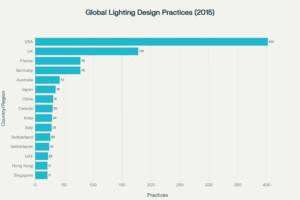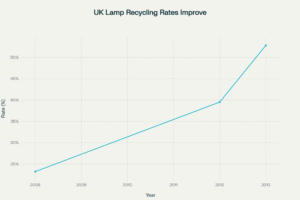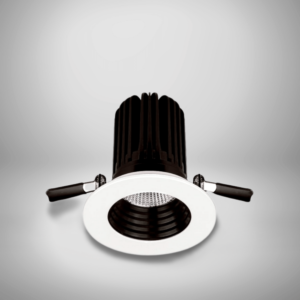Choosing between Casambi, DALI or a fixed approach comes down to brief, programme and lifecycle goals rather than brand hype.
A protocol is the language devices use to share data, and that matters for interoperability, commissioning and maintenance.
We’ll explain how LED drivers accept control inputs and why the input type matters more than internal modulation. We also cover energy savings, fault reporting and when analogue or wireless systems make sense.
Expect practical advice grounded in UK compliance, Part L, and real examples from our fittings. Our aim is to give clear ways to choose the right lighting control systems for each building type.
Why dimming matters now: efficiency, comfort and compliance in UK commercial lighting
Effective light control now sits at the intersection of cost, comfort and compliance in UK commercial spaces.
We prioritise energy and carbon savings while keeping workplaces productive. Reducing output to match need cuts wasted power and lowers bills. It also extends LED and driver life by running components cooler.
Digital systems like DALI give fine brightness levels and let multiple inputs work together. Automated strategies using occupancy sensors and daylight linking reduce run hours without manual action.
Task tuning keeps light in the sweet spot for visual comfort. That cuts glare and fatigue while meeting standards for offices and education.
Small investments in smart controls usually pay back quickly on large floorplates. Simpler rooms still benefit from basic, easy-to-maintain systems.

| Benefit | How it helps | Typical impact |
|---|---|---|
| Energy saving | Light only when and where needed | 10–40% lower energy use |
| Comfort | Task tuning and daylight linking | Reduced glare, higher productivity |
| Maintenance | Lower junction temps extend life | Fewer replacements, lower cost |
| Compliance | Presence control and schedules | Aids Part L targets |
Understanding the building blocks: drivers, signals and Dimming Protocols
Start with the hardware: the driver defines how a luminaire will behave for its lifetime. All LED modules need a converter to take 230V AC and deliver a controlled low current to the board.
LED drivers 101
The common commercial practice is a separate, accessible driver. It takes mains power and outputs a constant current at low voltage to the LED board.
How internal modulation works
Inside the unit the light is governed by two main methods. PWM (pulse width modulation or width modulation) cycles the LED fast to avoid flicker. Amplitude modulation varies current and can shift colour at very low levels.
Analogue, digital and wireless signals
The control input you pick—0/1–10V, a digital signal, a push‑dim or a wireless receiver—determines how the fitting joins a system. Analogue changes a voltage, digital sends addressed commands and wireless carries the same commands over radio.
- Practical tip: standardise driver families on a project to simplify spares and future refurbishment.
- Check minimum/maximum levels, fade times and emergency interfaces early to avoid surprises at handover.
DALI in depth: digital addressable lighting for scalable, data-rich control
When a project needs scalable zoning and fault reporting, a digital addressable approach pays off fast.
Topology and wiring
DALI uses two data wires plus mains. You daisy‑chain a two‑core bus and address each device.
One network supports up to 64 addressed devices. Grouping and scenes let you create flexible zones and preset levels.
Bidirectional feedback
The bus is bidirectional. Controllers can read faults, runtime hours and lamp status from each fitting.
This makes maintenance cheaper: dashboards and BMS links pull live diagnostics instead of guessing which unit failed.
Use cases and commissioning
Large open plans, schools and hospitals benefit most where zoning, multi‑input control and reporting matter.
- Combine wall plates, occupancy sensors and daylight sensors without signal clashes.
- Commission by addressing devices, mapping groups, defining scenes and setting fade profiles.
- Prefer DALI‑2 for long term, and avoid legacy DSI gear.
| Use case | Why DALI fits | Key benefit |
|---|---|---|
| Open‑plan office | Many luminaires with zoning and scene needs | Reduced cabling, flexible re‑zoning |
| School | Multiple inputs (panels, sensors) per classroom | Task tuning and simple timetabling |
| Hospital ward | Diagnostics and reliable maintenance logging | Faster fault resolution, less downtime |
Practical note: we engineer luminaires and drivers tested for dali compliance so commissioning is straightforward with mainstream toolsets.
Casambi explained: Bluetooth Low Energy mesh for flexible wireless control
Wireless mesh turns each fitting into a repeater, so coverage improves as you add luminaires. That removes the need for new signal wiring and speeds up installation on live sites.
BLE mesh fundamentals
Nodes in a BLE mesh are the drivers or nodes in each fitting. They receive and forward commands, making the network self‑healing as long as density is good.
App‑based commissioning and everyday use
Commissioning runs from a secure app. We set groups, scenes and schedules quickly, then hand over a simple controller app for clients to adjust in real time.
- Where wireless wins: refurbishments, listed buildings and fast roll‑outs where cabling is impractical.
- Resilience depends on mesh density, channel planning and quality drivers to keep the signal stable.
- Maintenance is easier: firmware updates, remote tweaks and simple device swaps without ceiling access.
| Scenario | Why Casambi fits | Key benefit |
|---|---|---|
| Retrofit in occupied space | No new trunking or long shut‑down | Faster programme, less disruption |
| Heritage building | Avoids fabric damage from cabling | Preserves building, meets conservation needs |
| Retail roll‑out | App scenes and fast commissioning | Rapid launch and flexible merchandising |
We offer Casambi‑ready luminaires or later field upgrades so projects keep options open. Always carry out pre‑deployment RF checks in congested spaces to ensure the mesh performs from day one.
Fixed output, 0-10V and 1-10V: where simple control still fits
When briefs demand low cost and quick install, analogue solutions often make the most sense. We keep simple options on the table — they are reliable, fast and cost‑effective with our drivers.
0-10V vs 1-10V: sink/source behaviour and wiring limits
0-10V sends a low DC voltage from the dimming driver to the led driver: 0 volts equals 0% (off) and 10 volts equals 100%.
1-10V is usually sinked by the driver and typically bottoms at ~10% until mains are switched off. That gentle curve helps colour stability at low levels.
Switch/push control and corridor function
Push or switch control uses a retractive switch on a dedicated terminal. Short press toggles, long press changes levels. It’s perfect where you want a single point of control without a central system.
- Wiring: a separate two‑core control pair plus mains to each driver; mind voltage drop on long runs.
- Limits: analogue is unidirectional — no feedback — and a typical channel supports around ten luminaires.
- Use cases: corridor function pairs with PIR or time switches for low‑cost absence/presence strategies in corridors and toilets.
Practical tip: label each led driver clearly for control type and terminal layout to cut installation errors and call‑backs. For larger, reconfigurable spaces, favour digital or wireless to avoid costly rewires later.
Wired vs wireless: reliability, installation and lifetime maintenance
The choice of cabling or Bluetooth shapes reliability, maintenance cost and how quickly a building can be handed over.
Wired systems give deterministic behaviour. A physical cable avoids RF congestion and keeps the signal predictable.
That matters for mission‑critical rooms and where access for repairs is limited.
Signal integrity and interference: cabling certainty vs RF planning
Cabled routes are immune to radio noise and keep latency low. They centralise power and control into panels and make fault tracing straightforward.
Wireless installs are faster and ideal for refurbishments or listed buildings. But they need RF surveys, channel planning and good node density to avoid dropouts.
Power, batteries and access: how maintenance differs over time
Mains‑fed devices reduce routine site visits. Wireless sensors or battery switches require scheduled replacement and clear access plans.
In practice: hybrid systems often win — wired DALI backbones with a wireless bridge give fast commissioning and long‑term serviceability.
- Wired: deterministic, low maintenance, easier diagnostics.
- Wireless: quicker install, flexible expansion, needs RF design and battery planning.
- Hybrid: balance of speed and lifecycle resilience; good for re‑zoning and analytics.
Document as‑builts, provisioning records and maintenance schedules. That keeps FM teams confident and reduces time and cost over the asset life.
Choosing the right protocol with Lumenloop: a practical framework
Project context — scale, access and handover speed — should drive the control decision, not feature lists.
Project drivers: scale, sensors, reporting, budget and programme
We start with the brief: number of zones, sensor needs and how much reporting the client expects.
If you need granular diagnostics and easy re‑zoning on large floorplates, dali typically wins. For fast, cable‑free roll‑outs in occupied or listed sites, a BLE mesh is often best. For simple rooms with fixed layouts, analogue control keeps cost and risk low.
Compatibility and future-proofing: drivers, luminaires and open standards
We favour open ecosystems first. Specify drivers that are swap‑in compatible across luminaire ranges so upgrades are straightforward.
Practical action: choose a driver family with clear terminal labelling and support for push‑switch and corridor functions. That saves time at refurbishment and reduces lifetime waste.
UK realities: existing fabric, listed buildings and Part L energy goals
Where fabric is protected, wireless avoids chasing new trunking and speeds programme delivery.
Part L targets push sensor‑rich digital schemes because they deliver measurable energy savings. We support commissioning and handover to get FM teams running quickly and to lock in benefits.
| Project need | Recommended approach | Key benefit |
|---|---|---|
| Large open plan | DALI with sensor groups | Granular control, diagnostics |
| Refurbish occupied space | BLE mesh (app commissioning) | Minimal disruption, fast install |
| Small fixed rooms | Analogue 0/1‑10V | Low cost, simple operation |
The Choice is Yours: Our Luminaires Support All Protocols
The right lighting approach balances install impact, ongoing service and energy goals.
Choose DALI where you need structured, digital addressable lighting with device feedback and zoning. Choose a BLE mesh for cable‑light rollouts; it removes the need for new signal wires and is commissioned via an app. For simple rooms, 0/1‑10V and push‑switch options keep costs low.
The driver you specify dictates how each led luminaire behaves, from pwm and AM control to corridor functions and push‑dim terminals. Sensors and timers automate output and trim energy while keeping brightness consistent.
We’ll help scope the work, pick the right dimmer and switch methods, and deliver a resilient lighting interface that suits your building and lifecycle needs.
FAQ
What are the main differences between DALI, Casambi and fixed-output control?
DALI is a wired, digital, addressable system offering precise control, two‑way feedback and integration with BMS. Casambi uses Bluetooth Low Energy mesh for wireless, app-driven commissioning and flexible groups without new data cabling. Fixed‑output systems (including 0‑10V/1‑10V or simple on/off) are low‑cost, low‑complexity options suited to small installations or where only basic dimming is required. Choose based on scale, retrofit constraints and the need for diagnostics and reporting.
When should we favour wireless BLE mesh like Casambi over a wired DALI network?
Use wireless where running new cables is impractical — think refurbishments, listed buildings and fast roll‑outs. BLE mesh is quick to commission and flexible for changing layouts. For large floorplates, heavy sensor integration or strict reliability/EMC requirements, wired DALI typically remains the safer long‑term bet.
How does a LED driver affect dimming performance?
The driver translates control signals into current or voltage for LEDs. A quality constant‑current driver with proper control inputs (DALI, 0‑10V, PWM, BLE gateway compatible) ensures smooth dimming, stable colour and no flicker. Mismatched drivers can cause limited dim ranges, flicker or loss of colour consistency.
What’s the difference between PWM and amplitude modulation inside a driver?
PWM (pulse‑width modulation) rapidly switches current on and off to change perceived brightness; it preserves LED colour and works well at low levels. Amplitude (or analogue) modulation reduces the driver output current directly, which can alter colour point and may not be supported by all LEDs. The best choice depends on driver design and the luminaire’s colour‑control requirements.
How many devices can be on a single DALI network and what wiring does it need?
A standard DALI line supports up to 64 addresses and uses a simple two‑core data pair with low voltage. Multiple lines can be bridged via controllers or gateways for larger systems. Topology is forgiving — line, star and ring work — but you should follow manufacturer guidance for cable length and termination to maintain signal integrity.
Can DALI provide status and fault reporting to a BMS?
Yes. DALI supports bidirectional communication, so drivers can report lamp failures, presence, current consumption and other diagnostics. That data can be aggregated by a lighting controller or gateway and forwarded to a BMS for energy monitoring and maintenance planning.
What are common use cases where fixed 0–10V or 1–10V still makes sense?
0–10V and 1–10V suit simple zones, small offices, corridor lighting and legacy retrofits where budget or wiring simplicity matters. They’re ideal when you need straightforward dimming from a basic sensor or switch without the cost or complexity of addressing and advanced telemetry.
How do 0–10V and 1–10V differ in wiring and behaviour?
The key difference is sink/source behaviour: 0–10V typically expects a current sink from the controller, while 1–10V uses a sourcing control. This affects wiring and compatibility with controls. Check your sensors and drivers for matching sink/source requirements to avoid erratic dimming.
What reliability concerns should we weigh when choosing wired vs wireless systems?
Wired systems offer predictable signal integrity and minimal RF interference risk. They generally require less ongoing tuning. Wireless systems need RF planning (to avoid dead spots), battery management for battery‑powered devices and occasional mesh optimisation. Consider maintenance access, long‑term uptime targets and the building’s interference profile.
How does choosing a protocol affect lifetime maintenance and energy reporting?
Protocols with two‑way communication (DALI, many BLE solutions with gateways) allow remote diagnostics, usage logging and scheduled maintenance — reducing site visits and downtime. Simpler systems provide less telemetry, so energy reporting and proactive maintenance are harder and often manual.
What practical factors should guide protocol selection for a UK commercial project?
Start with project scale, required control granularity, sensor strategy, budget and programme. Factor in existing fabric (listed status), Part L compliance and future upgrade paths. Prioritise open standards and compatible drivers to avoid being locked into a single vendor.
How do sensors and occupancy controls integrate with these systems?
Sensors can connect directly to DALI networks, communicate via BLE mesh, or interface through 0–10V/relay circuits. DALI and modern BLE solutions support advanced sensor data and scene control; simpler systems rely on local switching logic. Choose sensors that match your control backbone for full functionality.
Can we mix protocols within one installation?
Yes. Hybrid systems are common: DALI for main distribution and Casambi for flexible zones, or 0–10V for ancillary spaces. Gateways translate signals between protocols, allowing phased upgrades and staged budgets while keeping controls interoperable.
What should we check for driver and luminaire compatibility before procurement?
Confirm supported control inputs (DALI, 0–10V, PWM, BLE), dimming curve performance, flicker metrics and thermal behaviour. Verify firmware updates, open‑standard support and that the luminaire’s photometrics remain consistent across the dimming range.
How do regulations like Part L influence our choice of lighting control?
Part L sets energy efficiency targets; intelligent controls that enable daylight harvesting, presence detection and scheduled setbacks make compliance easier. Digital systems with reporting simplify evidence for compliance and ongoing energy management.












